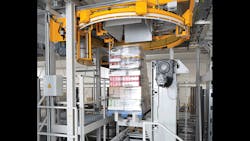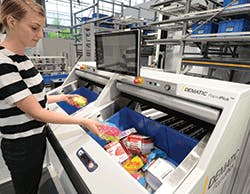Food & Beverage: Technology as a Profit Preservative
Companies in the food and beverage industries are looking for new ways not only to stay ahead of their competitors, but to stay ahead of the laws regulating them. Of most interest to them, and to those watching how they're going to comply with it, is the Food Safety Modernization Act coming out of the Food & Drug Administration (FDA). Up to now the FDA wasn't specific on how food was to be transported safely, but the FSMA has a detailed set of such requirements that take effect in 2015. These affect:
- Vehicles and transportation equipment (including design and maintenance to ensure equipment does not cause the food that it transports to become contaminated);
- Transportation operations (the measures taken during transportation to ensure food is not contaminated, such as adequate temperature controls and separation of food from non-food items in the same load);
- Information exchange (procedures for exchanging information about prior cargos, cleaning of transportation equipment, and temperature control between the shipper, carrier, and receiver);
- Training (training of carrier personnel in sanitary transportation practices and documentation of the training);
- Records (maintenance of written procedures and records by carriers and shippers related to transportation equipment cleaning, prior cargos, and temperature control).
These requirements will change how supply chain partners work with each other and even how they work internally. For example, Ben E. Keith Foods, a food service distributor, has a new distribution center in Missouri City, Texas, southwest of Houston. It serves restaurants in the Houston market as well as in eastern Texas and in southern Louisiana. The DC handles 15,000 items in eight temperature zones, which are all variants under the three basic temperature zones: ambient (dry), refrigerated and frozen.
"We always have a person that gets an alert by laptop or cell phone if the temperature falls out of range," Keith Pittman told the International Foodservice Distributors Association, which highlighted this operation in a recent report. He's senior vice president of operations at Ben E. Keith Foods. "If it gets too cold or too warm, they take action to remedy it. That's part of our food safety plan, 24 hours a day."
Automating Food's Flows
Material handling system providers are developing expertise to help food & beverage companies maintain safe supply chains. Of course safety applies to the workers inside these environments as well as to customers. Sean O'Farrell, market development director for Dematic (www.dematic.com), says making workers safe and comfortable is key to keeping these employees. That's a major issue in any distribution job, but especially when the challenges of food and grocery are added.
"Those industries are pretty tough on labor when it comes to the number of cases picked per day per person, and with those average weights it could be ten tons of product per shift," he says. "It's a young man's game, so those workers either need to be better compensated or these employers will keep going through the cycle of replacing workers. Those companies that haven't automated in the past and may have complemented with some voice picking and a little conveyor are now looking at ways to handle a pallet from receiving, assembling and storage at a case level and then assembling pallets automatically if possible."
Although using 3PLs to fulfill orders is a growing trend, the demand for new services like store-ready mixed-SKU pallets that can just flow through the customer's distribution operations and then be sent on to the retail store requires a higher level of supervision.
"The biggest challenge is omni-channel, being everything to everybody," says O'Farrell. "The grocery retailer typically had one store format or two at the most. Now they have multiple formats from mega retail stores down to convenience stores and everything in between."
That makes for a more complex order profile. Instead of a mega retail store getting one truckload of product every other day, they may now get smaller orders in more frequent deliveries daily along with a convenience store order that might only represent one or two pallets worth of product. It could also be one person ordering something on their mobile device and wanting it delivered directly to their home, or to pick it up somewhere. That could be two totes worth of product, one chilled or frozen and the other ambient temperature, delivered to the ground level of a condo complex.
O'Farrell says that trend will lead to the rise of mixing centers just outside of urban centers to which product will be shipped in truckloads, orders will be assembled and product will be delivered into city centers on smaller trucks doing more frequent deliveries. As discussed during MH&L's annual Editorial Roundtable, the top ten metropolitan statistical areas in the United States represent 27 percent of the population. If you factor in the top 30 metropolitan statistical areas, that's 45 percent of the population. That explains why the goal for Amazon Fresh was to be in 20 of those locations by 2013. That number could soon double to serve about half of the nation's urban populations.
Those smaller, more frequent deliveries will be made on smaller pallets and in totes, O'Farrell says.
"I'm working with a couple companies to come up with a standard size, whether a half or quarter pallet, a display pallet or a roller container, for use in the North American marketplace," he adds. "It could be interchangeable with other companies' and good for automation within the distribution environment. It will also benefit the environment if you have reusables."
More automated handling systems are being designed to handle reusable platforms, O'Farrell adds. He cites Dematic's multishuttle system that can handle both totes and corrugated cartons, delivering both for staging, storage or replenishment of a flow rack where piece picking might be taking place on the other side of the rack. Systems providers are also looking at the application of robots for piece picking out of totes.
"There is a cost issue in the fact we have so many different size SKUs in the order fulfillment operations of many companies," he notes. "We've been in R&D for the last year to address this. We also have an automatic palletizing system rolling out next year that can palletize cases and totes on the same pallet for mixed SKU pallet build. The palletizer can build to a standard GMA pallet or to a roll container or half pallet. This is part of a puzzle logic system where we're building the pallet ahead of time based on the cube of the cases and business rules like crushability, whether it's a high-theft item that you may want to bury in the middle of the pallet, and where it resides in a store aisle. We build the pallet to be store friendly and aisle ready for replenishment or restocking of the shelf. That saves labor in the retail store."
This also contributes to truck utilization. There are more trucks on the road than ever, and more shippers want to reduce that traffic. To do that, it's best to cube out a trailer as much as possible.
Beverage Offers Toast to Technology
On the beverage side of food & bev, shelf-life issues conspire with ever-multiplying SKUs to raise the complexity bar for manufacturers and distributors. Combined with the variety of store formats just discussed, efficiency demands some level of technological sophistication on the fulfillment side. That's why more and more beverage companies are adopting warehouse management systems (WMS). That's also why WMS providers are developing expertise in this space.
"We started to work in the beer industry six years ago, and at that time there were maybe less than 20 companies in the entire country that had any type of WMS technology at all in the beer business," says John Bryant, CEO of AGI (www.agiworldwide.com), a WMS vendor serving customers like Silver Eagle, the largest distributor of Anheuser-Busch products in the U.S. and the second largest beer distributor in general. "Today it's over 60%, on a case volume basis. Our biggest challenge is to be able to provide and deliver the technology in a cost effective manner so that companies that do 2 million cases or less can afford it."
No matter what size the beverage manufacturer or distributor, proximity to customers and truck utilization are universal cost challenges. That's why Silver Eagle has chosen to build facilities closer to key markets and to use logistics technology to make best use of those facilities.
"If you weigh the differences with the drive time, it's worth it to be closer to the customer," Bob Boblitt told MH&L during a tour of Silver Eagle's Houston DC a year ago. He's the company's executive vice president and COO. "Our enemy is windshield time. I can't tell you the number of times our customer said the competition isn't servicing them with the frequency they want because they're too far away. We have sites located generally so we can service those special events our customers promote."
Silver Eagle is rolling out AGI's WMS throughout its entire system, including a new site in Pasadena, Tex. This is a location-based inventory system in which every SKU has a place—and given the location requirements of a product like beer it allows management to know what product is on current pull. Silver Eagle has grown so rapidly and taken on so many SKUs over such a short period of time that even a year ago it was anxious to get its Pasadena facility up and running. This facility adds 240,000 sq ft of warehousing space to the network and creates better transparency so management can better observe performance and set benchmarks.
The benefits of their WMS extend to the delivery process. Silver Eagle is sequencing their routes throughout all locations, which they had not done in the past, according to Bryant.
"When they sequence their routes we're able to use technology to build the pallets to the top of each bay in order delivery sequence," he says. "We're able to have full pallet utilization in the warehouse. It optimizes the delivery side, fleet utilization and the warehouse. Their customers' demands, particularly their larger clients, are increasing. That means they need to take advantage of automatic ship notices, particularly for Walmart and the large grocery store chains, and they need compliant labeling so that the big chains can receive product very quickly."
Climate control adds another layer of complexity for the beverage business, especially in the growing craft beer industry.
"We're seeing a growing trend among craft beer wholesalers and manufacturers that require a cooler stored environment or at least climate controlled which is driving up the cost of their facilities and changing how they fulfill those orders from a picking process in the warehouse," Bryant says. He adds that staffing changes and order volatility make some level of automation a necessity.
"At Silver Eagle's San Antonio facility they can have 20,000 cases to fulfill in one day and 60,000 the next," he concludes. "They can't staff affordably the whole time for 60,000 cases so they need technology in place that can leverage a flexible temporary staff to handle those high volume periods. But also since they take their orders until a cutoff time of 6:30 pm and it has to be delivered the next morning, they need the flexibility in the facility to be able to fulfill all of those orders in one night."
About the Author
Tom Andel
Editor-in-Chief
Tom Andel is an award-winning editorial content creator and manager with more than 35 years of industry experience. His writing spans several industrial disciplines, including power transmission, industrial controls, material handling & logistics, and supply chain management.

